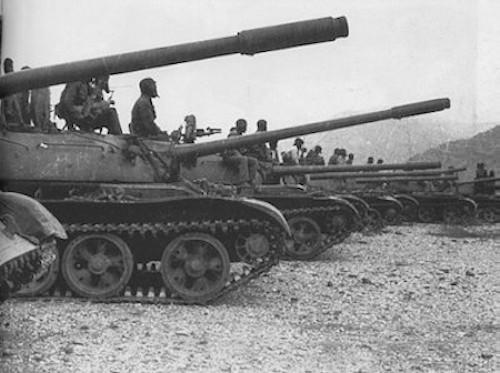At first things seemed to proceed according to plans: within a few days the joint forces of SNA and WSLF occupied the cities of Kelafo and Kebre Dehar and about the 60% of the entire territory of the claimed Ogaden.
The Ethiopian forces absolutely did not succeed, at least in this first juncture, to stem the spread of Somali forces. The initial surprise factor and the steady and decisive support of military aviation prevented the Ethiopians - coupled with the use of unified units by SNAs - to withstand, thus forcing them to retreat.
The Somali columns in the meantime pushed deeper into the south of the region, to the Uebi Shebeli river basin, to conquer Gode's air base, as well as to Harar and Dire Dawa, representing the gateway to Addis Ababa.
If things were bad for the Ethiopians on the ground, things were much better in the sky. In air-to-air combat, the Ethiopian Aeronautics proved its value from the start by knocking out four MiG-21MFs, the 16 July 1977, thanks to two F-5s piloted by Israeli mercenary pilots.
The 17 August 1977, elements of the SNA reached the outskirts of Dire Dawa which constituted the terminus of the Red Sea railway, vital to the economy and daily life of Ethiopia.
The city was not taken immediately by the Somalis as a series of tactical mistakes made their initial attacks were rejected with heavy losses in shelled vehicles. The same happened for the conquest of the city of Jijiga a few days later.
The 13 September 1977 SNA forces, at the second attempt, with the help of corrugated means, managed to occupy Jijiga when the Ethiopian Army forces fired.
At that point, the Somali forces aimed at Harar and laid siege with the 3 Division of the Ethiopian Army inside.
The aerial war in the meantime, however, was worse for Somalis: F-5A duels always saw winners so much that they significantly reduced the SAC's available staff, creating inevitably a somewhat slowdown in Somali operations.
The USSR had until then tried to mediate to achieve at least one ceasefire. Subsequently, however, he decided to engage himself in the first person in the conflict by sending several military advisors on the Oppad front alongside Ethiopian troops. Their relationships highlighted a fundamental thing: Ethiopia's difficulties were to be found in human-than-technological-type factors. Mengistu's troops were demoralized and absolutely in need of reliable and trained units. Moscow then decided to create an ad hoc shipping body mainly made up of Cubans equipped by the USSR. Plan to which Castro gave his assent only after an initial phase of indecision and doubt.
(Continued)
Read also the first part: "the historical and political premises of the conflict"












